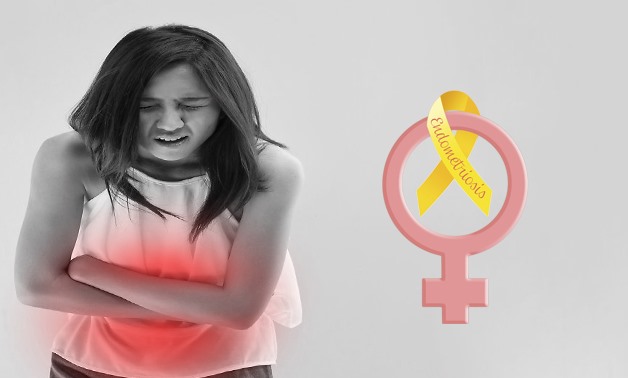
Creative Commons
Menstruation, ovulation pains, pre-menstrual syndrome (PMS), menstrual cramps; they’re all considered rather private matters that are either swept under the rug or discussed with close friends only. Young ladies in Egypt are often too shy to discuss menstruation with their parents, let alone raise a flag when they feel something isn’t quite right.
I had recurring pains for months; awful, crippling pains that had nothing to do with menstruation but that kept me in bed. A couple of doctors just dismissed it as normal pains women go through before menstruation, during ovulation, or just another sort of womanly pain. It wasn’t. Around eight months later, a gynecologist told me I had endometriosis. I didn’t have any idea what that is, so, naturally, I asked. He just went on about how I have been married for over three years and that it was time for me to think about pregnancy, that pregnancy would resolve my endometriosis—I still didn’t understand what that was—and then he handed me a list of instructions to help with conception. That was it; nothing on what the condition is, how to ease the pain or whether there is any treatment.
I left his office perplexed and unsure how I should be feeling; should I be trying to conceive? Should I go to another doctor? Does it affect fertility? So I did what any nerd would do and hit my dear friend Google to find out about one of the lesser-discussed issues women go through. This is a condition that one in every 10 women of reproductive age endure, which amounts to a total of 176 million women.
However, unfortunately, it takes on average 7.5 years to get a diagnosis of endometriosis. Because pains in the pelvis are often associated with menstruation, women do not normally report them, even when they become intense, and they’re often told by their mothers or friends that it’s normal to have them. So a woman doesn’t see a specialist until the pains are excruciating, or until she encounters fertility issues. Around 40 percent of women with endometriosis face infertility issues, and those are often the ones who get medical attention. This means that the remaining 60 percent are often left popping painkillers and are told to just suck up the pain.
Since your doctor, mom and friend are unlikely to mention endometriosis as a possible underlying cause behind pains, here is everything you need to know about the widespread condition.
What it is?
Endometriosis is a condition where cells that are similar to the lining of the uterus are found elsewhere in the body and act like the lining of the uterus, shedding and bleeding monthly during menstruation. But while the uterus expels the shedding out of the body, the cells found outside of the womb can’t, so this causes inflammation of the surrounding tissues and area.
What it does?
The condition often causes infertility issues, pain, heavy and painful periods as well as bowel and bladder problems. It also leads to inflammation, scar tissues, lesions and adhesions in the pelvic area.
What it isn’t?
Endometriosis is not a hormonal imbalance, it is not infectious or contagious and is not cancer.
The symptoms
* Pain during ovulation, before or during menstruation (mild pain during menstruation and ovulation is normal but pain that interferes with your ability to carry out normal daily activities is not.)
* Heavy periods.
* Painful intercourse.
* Infertility issues.
* Painful bowel movements (often confused with irritable bowel syndrome).
* Spotting and bleeding between periods
How it is diagnosed?
Endometriosis is difficult to diagnose because the symptoms are either brushed off as a normal reproductive cycle, misdiagnosed as irritable bowel syndrome or go unnoticed by the patient.
Another reason it is difficult to diagnose is that unless there are chocolate cysts (cysts filled with blood that are telltales of the disease), nothing appears through ultrasound or other non-invasive methods like blood tests and examinations. The only way to diagnose it is through laparoscopy to spot lesions, adhesions, scar tissues and chocolate cysts.
Treatment
Endometriosis is a chronic condition that cannot be cured but can be managed to ease the pain and other symptoms. Each case is different, depending on the severity of the endometriosis, or the location and the symptoms it is manifested through. It is important to remember, however, that contrary to popular belief, pregnancy does not cure the condition; it does alleviate the symptoms so long as there is no menstruation, but once the body starts menstruating again, the symptoms are likely to return.
To deal with the pain, you can try hot water bottles and taking painkillers that also work as anti-inflammatories when necessary. The pain killers, however, work best when they are taken before you start feeling the pain; monitor yourself and know when the pain is at its worst so you can preempt it with medicine. An active lifestyle and healthy eating habits, although not scientifically proven to help, have been reported to ease the pain.
Your doctor may suggest laparoscopic surgery to destroy deposits of endometriosis, which will give temporary relief although the symptoms are bound to recur. A laparoscopy is beneficial to improve fertility, relieve adhesions around the organs and ease the pain. In severe cases, the doctor may suggest a hysterectomy or oophorectomy, removing the uterus or the ovaries, although this is normally an option kept for those who do not wish to bear children and are suffering crippling pains or serious issues.
Another possible treatment path is hormonal treatment through reducing the production of oestrogen, which then reduces how active the endometriosis cells are. This is normally done through contraceptive pills, or hormonal coils like the Mirena; if you opt for it, make sure you educate yourself about all the side effects of this treatment.

Comments
Leave a Comment